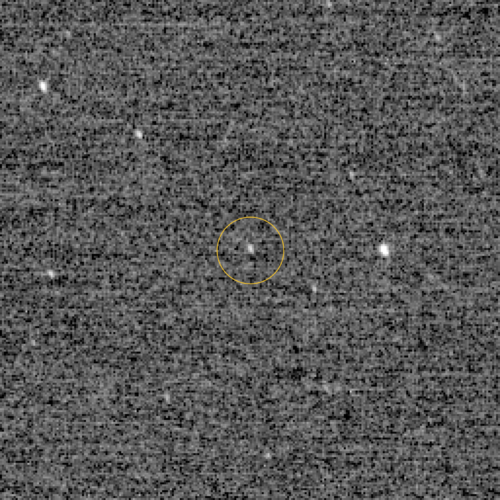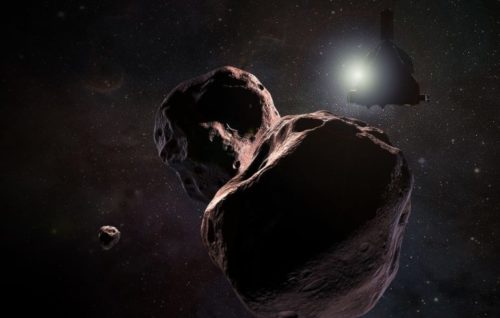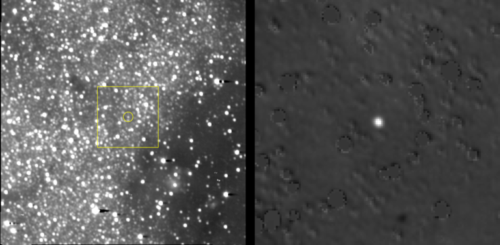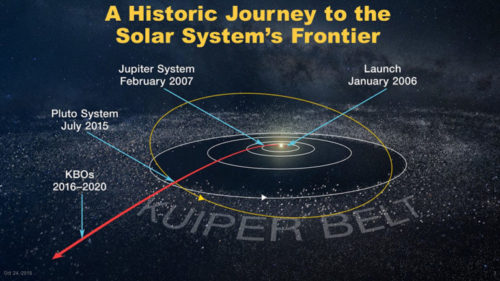
NASA’s New Horizons spacecraft is now only two days away from a historic rendezvous with its next target – Ultima Thule. At 4 billion miles away, the Kuiper Belt Object (KBO) will soon become the most distant thing in the Solar System ever visited by humanity, and New Horizons is locked on and on final approach at nearly 1 million miles per day for its close encounter on Jan. 1, 2019.
Follow our New Horizons Tracker for updates & LIVE COVERAGE of the flyby here!
Flyby will occur just after 12:33am EST on Jan. 1, 2019 (9:33 pm PST on Dec. 31, 2018).
Ultima Thule is about one billion miles beyond Pluto. New Horizons is known, of course, for its historic flyby of Pluto and its moons back in 2015.
Ultima Thule is a very small rocky body, much smaller than Pluto – only about 16 miles (25 kilometers) in diameter. But it will provide valuable information as to how these KBOs – rocky debris left over from the formation of the Solar System – originated.

Since Ultima Thule is so small and dim, that means that conducting a flyby of it is more difficult than Pluto.
“This flyby is a lot harder than Pluto,” said New Horizons Principal Investigator Alan Stern. “Ultima is tiny, and faint, much harder to navigate on… Another difficulty, or challenge, really, is that we’re farther away, and that means communication times are longer. Bit rates are lower.”
“It’s a one-shot, ‘get it right or go home’ deal, because there’s no U-turn to go back and have a re-do… You have to plan every chess move with the spacecraft more carefully.”
New Horizons will also pass closer to Ultima Thule than it did Pluto, at a distance of 2,200 miles – less than a third of the distance of the Pluto flyby. The images it sends back during the flyby will be even higher resolution than those taken at Pluto. According to Stern:
“We will obtain geologic mapping resolutions as high as 35 meters (110 feet) per pixel using LORRI. By comparison, our highest resolution Pluto mapping was about 80 meters (260 feet) per pixel.”
Everything is still on track for the flyby and the spacecraft remains healthy.

One unusual anomaly was detected recently though – not with New Horizons, but with Ultima Thule itself. Even though the object is still just a bright dot of light right now, New Horizons has taken hundreds of images for navigation purposes. But those images have produced a mystery.
Scientists determined back in 2017 that Ultima Thule is probably elongated in shape, not spherical, and may even be two smaller bodies joined together. But the brightness variations that New Horizons has seen don’t match that – a rotating object of that shape. The periodic variation in brightness during every rotation produces what scientists refer to as a light curve.
“It’s really a puzzle,” said Stern. “I call this Ultima’s first puzzle – why does it have such a tiny light curve that we can’t even detect it? I expect the detailed flyby images coming soon to give us many more mysteries, but I did not expect this, and so soon.”
So what is the explanation? Scientists don’t know yet, but they have some ideas.
“It’s possible that Ultima’s rotation pole is aimed right at or close to the spacecraft,” said Marc Buie, of the Southwest Research Institute.
“Another explanation,” said the SETI Institute’s Mark Showalter, “is that Ultima may be surrounded by a cloud of dust that obscures its light curve, much the way a comet’s coma often overwhelms the light reflected by its central nucleus.” That explanation is plausible, Showalter said, but such a coma would require a source of heat to generate, and Ultima Thule is too far away from the Sun for that.
“An even more bizarre scenario is one in which Ultima is surrounded by many tiny tumbling moons,” said University of Virginia’s Anne Verbiscer, a New Horizons assistant project scientist. “If each moon has its own light curve, then together they could create a jumbled superposition of light curves that make it look to New Horizons like Ultima has a small light curve.”
We will know soon enough however what the answer is.

“It’s hard to say which of these ideas is right,” Stern said. “Perhaps its even something we haven’t even thought of. In any case, we’ll get to the bottom of this puzzle soon – New Horizons will swoop over Ultima and take high-resolution images on Dec. 31 and Jan. 1, and the first of those images will be available on Earth just a day later. When we see those high–resolution images, we’ll know the answer to Ultima’s vexing, first puzzle. Stay tuned!”
Note about government shutdown:
One other problem has nothing to do with the mission itself, but rather is political. Due to the current government shutdown, coverage of the flyby will be more limited than usual. There has been some confusion as to whether the flyby will be shown on NASA TV, as normal, or not. Reports up until yesterday said it won’t be, but now the NASA Live website says it will.
Updates will for sure be provided however on the Johns Hopkins Applied Physics Laboratory’s YouTube channel and website. You can also follow Stern’s twitter feed at @NewHorizons2015 or @AlanStern for live updates of the mission.
“What’s really a shame is this is truly historic,” New Horizons Principal Investigator Alan Stern told Floriday Today on Thursday. “It’s the farthest exploration of worlds in history and without NASA able to get the word out, I think it’s going to be very much diminished for the public and that’s an unintended consequence of this shutdown.”
More information about New Horizons is available on the mission website.
.
.
.
.
FOLLOW AmericaSpace on Facebook and Twitter!
.
.
.
Missions » New Horizons »




